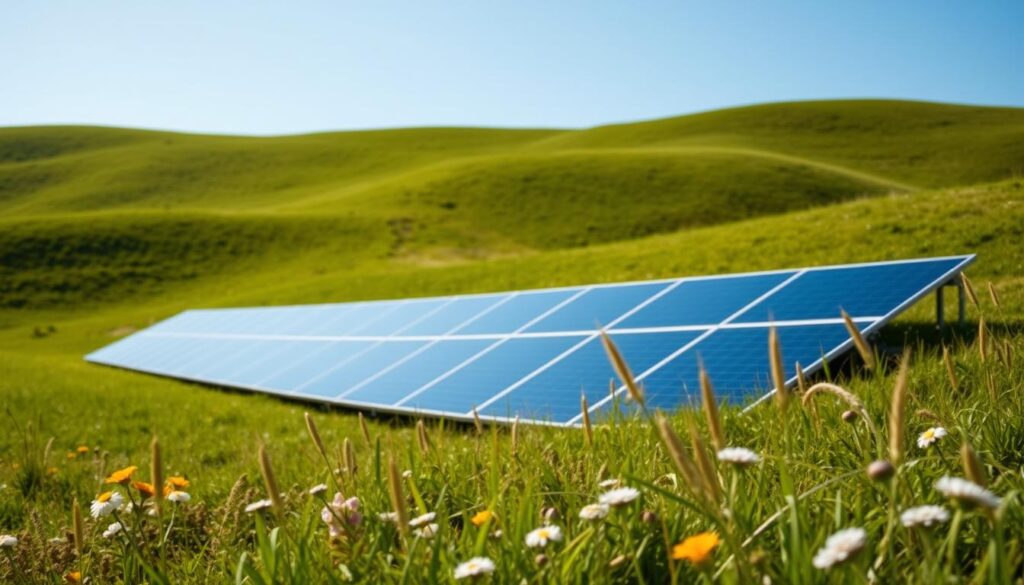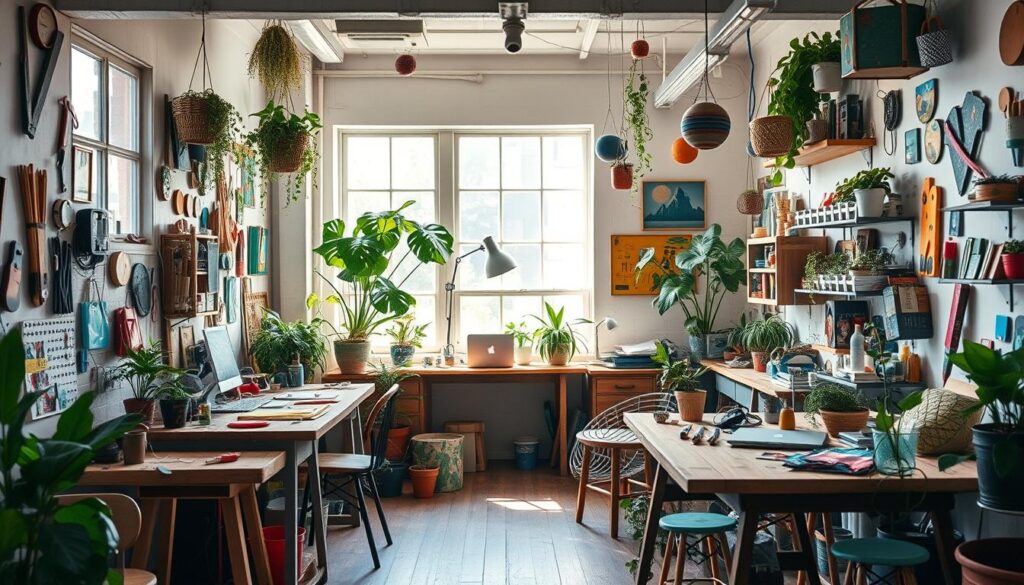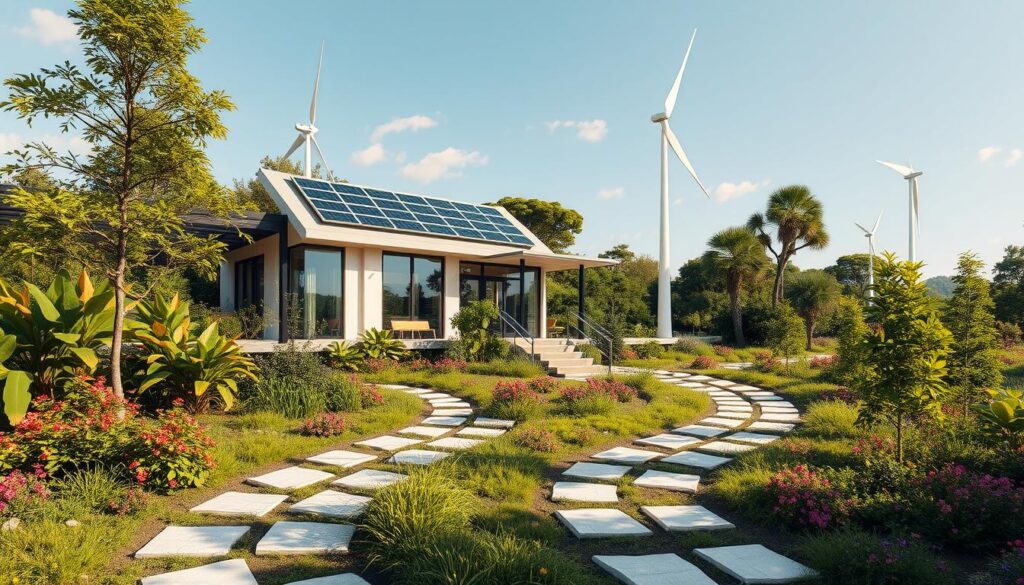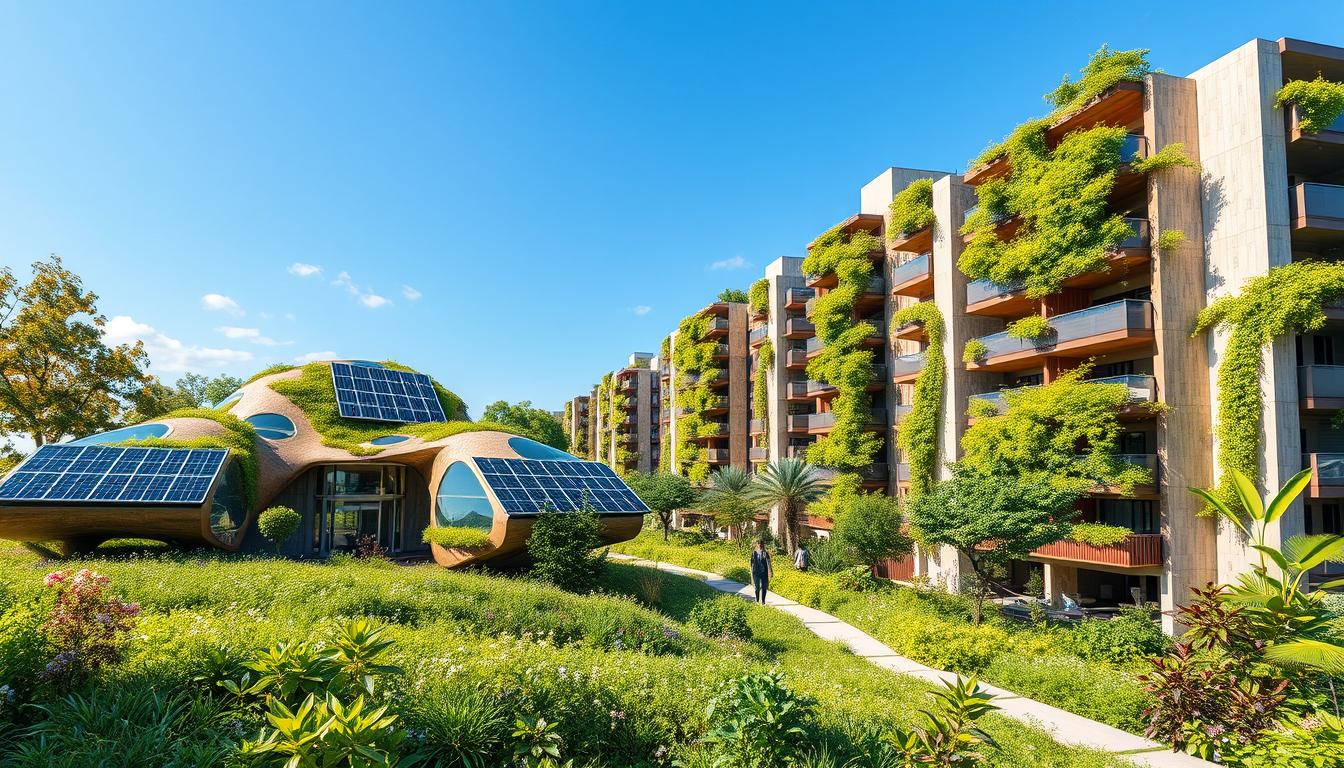In today’s world, we all need to care about the environment. As creators, we must use sustainable design to lessen our harm to the planet. Sustainable design is more than just looking good. It’s about making things that work well and are good for the Earth.
At the heart of sustainable design is finding new ways to solve problems. We aim to create things that are good for people and the planet. By using eco-friendly ideas, we make products and spaces that look great and are kind to the Earth.
This guide will cover the basics of sustainable design. We’ll look at the key principles, how to measure success, and more. We’ll also show how eco-friendly practices can change the world in fields like green buildings and saving energy.
Our goal is to help you, as a creator, make a difference. We want you to create things that not only impress but also help our planet.
Understanding the Foundations of Sustainable Design and Environmental Impact
As creators, it’s key to understand ecological design and its role in environmental impact. Sustainable design focuses on a product’s whole life, from start to end. It aims to follow nature’s example, where nothing is wasted and resources keep flowing.
We use tools like Life Cycle Assessment (LCA) to measure our designs’ sustainability metrics. LCA shows us where we can cut down on harm. Standards like LEED and BREEAM also help us see how green our projects are.
Core Principles of Ecological Design
Ecological design is all about learning from nature. It uses nature’s ways to find new, green solutions. This approach makes our designs better for the planet and more lasting.
Environmental Impact Assessment Methods
To really get how our designs affect the planet, we need strong tools like LCA. It looks at a product’s whole life, from getting materials to when it’s thrown away.
Sustainability Metrics and Standards
The design world has set up sustainability metrics and standards to help us make better choices. LEED and BREEAM are big names in this field. They check how green buildings and communities are.
Sustainable Design, Eco-Friendly Practices in Modern Creation
The world is waking up to the harm our actions cause. Sustainable design is key to making products and services that are kind to the planet. Leading companies are leading the way with eco-friendly practices. They’re not just reducing their carbon footprint but also sparking innovation and change.
Interface is a global leader in sustainable design. Their “Mission Zero” initiative has changed how they make things. They’ve cut waste, use renewable energy, and make products from recycled and upcycled materials. This shows that modern creation can be good for the planet and profitable too.
Patagonia is another great example. They’re known for their eco-friendly clothing. They use organic and recycled materials and power their places with renewable energy. Their work shows how to make a business that cares for the environment.
Green Architecture: Building for a Sustainable Future
Green architecture is changing the world for the better. It uses passive design strategies, natural building materials, and biophilic design. Architects are leading the way to a greener future.
Passive Design Strategies
Passive design is key in green architecture. It uses nature to control a building’s temperature and cut energy use. This includes smart solar orientation and the right window placement for air flow.
It also uses materials that absorb and release heat well.
Natural Building Materials
Green architecture also focuses on natural building materials. These include bamboo, rammed earth, and reclaimed wood. They’re good for the planet and make buildings look and feel better.
These materials are often low in carbon and can be found locally. This reduces the project’s environmental impact.
Biophilic Design Elements
Biophilic design connects people with nature. It adds features like living walls and indoor gardens. This improves well-being and makes buildings feel more natural.
Green architecture is changing how we build and live. It’s leading us to a more sustainable and peaceful future.
Energy Efficiency and Renewable Resources Integration
Modern creators are focusing on sustainable designs. They aim to reduce our carbon footprint and use clean energy. This is key to powering our creations.
Solar panels are a promising solution. They turn sunlight into electricity. Companies like Tesla have made products like the Powerwall. It helps manage and store renewable energy at home.

We’re also looking into wind turbines and geothermal systems. These use natural resources to power our designs. They help us use less fossil fuel and make our creations more energy-efficient.
We’re adding energy-saving lights and HVAC systems to our designs. This makes our work more sustainable. It helps reduce the environmental impact of our projects.
Innovation in sustainable design is ongoing. We’re committed to using energy efficiency and renewable resources. Our goal is to inspire a greener, more sustainable future with our designs.
Material Selection and Lifecycle Assessment
Choosing the right materials is key to sustainable design. We need to think about their looks, function, and environmental effect. This whole view helps cut down our creations’ carbon footprint.
Recycled and Upcycled Materials
Using recycled materials and upcycling can greatly reduce our need for new resources. Brands like Adidas are leading the way. They’ve created the Futurecraft.Loop shoe, showing how design can support a circular economy.
Circular Economy in Design
The circular economy changes how we design. It moves away from the old “take-make-waste” way. Instead, it keeps materials in use, saving resources and reducing waste for a greener future.
Durability and Longevity Considerations
Designing for durability is also crucial. Making products that last longer means they need to be replaced less often. This lowers their environmental impact over time.
Waste Reduction Strategies in Design Process
We must focus on reducing waste in our design work. Using waste reduction strategies helps us lower our environmental footprint. It also makes our design process better and supports eco-friendly practices. Let’s look at ways to change how we make and throw away things.

Zero-waste design is a key strategy. It aims to cut out waste by using materials wisely and designing for easy take-apart. This way, products last longer and can be fixed, updated, or recycled, reducing landfill waste.
Philips’ circular lighting is a great example of waste reduction in action. They lease their lights instead of selling them. This means materials are reused, creating a loop that cuts down on waste and supports sustainability.
Digital Tools and Technologies for Sustainable Design
We’ve adopted many digital tools for eco-friendly design. These include environmental impact software and energy modeling tools. They help us make better choices and cut down on carbon emissions.
Environmental Impact Software
Software like SimaPro and GaBi is key to our sustainable design efforts. These environmental impact software tools help us track our designs’ life cycles. They show us where we can use less resources and waste less.
With these tools, we can make choices based on solid data. This way, we meet our environmental goals.
Energy Modeling Tools
It’s important to accurately predict and manage energy use in sustainable design. Energy modeling tools like EnergyPlus help us do this. They let us see how our projects will use energy.
These tools help us design buildings and systems that use less energy. We can try out different designs and find the best ones. This way, we can use more renewable energy sources.
Virtual Prototyping Solutions
We no longer need to make physical prototypes and waste materials. Virtual prototyping solutions have changed the game. They let us test and improve our designs digitally.
With digital tools, we can try out many designs. We can make our ideas better and get to the final product faster. All while being kinder to the environment.
These digital tools are essential for sustainable design. They help us use data, energy modeling, and virtual prototyping. This way, we can create designs that are not only beautiful but also good for the planet.
Carbon Footprint Reduction Through Smart Design
We have a big responsibility to cut down the carbon footprint of our designs. By using smart design principles, we can lessen the harm to our planet. This helps us build a greener future.

The key to reducing carbon footprint is lifecycle thinking. We need to think about the impact of our designs from start to finish. This way, we can find ways to cut down on carbon at every step.
Companies like Microsoft are leading the way. They aim to be carbon negative by 2030. They use smart design like sustainable materials and renewable energy. By following their example, we can make our world more environmentally conscious.
Implementing Sustainable Design in Business Practice
Sustainability is now key for businesses and consumers. We must add eco-friendly practices to our design work. A cost-benefit analysis helps see the value of sustainable design. It balances initial costs with long-term savings and less environmental harm.
Client Communication Strategies
Talking clearly with clients is vital for sustainable design success. We need to share the good points of eco-friendly design. This includes less energy use, better brand image, and more customer loyalty.
Highlighting certification and following rules shows we’re serious about the environment. This makes clients trust us more.
Certification and Compliance
Getting certifications like Cradle to Cradle or B Corporation boosts our business practice. It shows we care about the planet. Keeping up with new rules and standards is also important.
Conclusion
Our journey through sustainable design and eco-friendly practices has left us feeling hopeful. We now see how crucial designers are in making our future greener. Sustainable design, from using energy wisely to choosing materials carefully, can change how we build and live.
We’ve seen how sustainable design can cut down on harm to the environment and spark new ideas. By adopting these practices, today’s creators can help lead to a greener, more aware world. It’s our duty as designers to make these values a part of our work, pushing for change.
Let’s keep exploring sustainable design, using new tech and creative methods to see what’s next. This way, we can help create a world where caring for the environment and being creative go together. Together, we can build a better, greener future for all.



